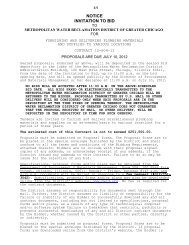Report - Metropolitan Water Reclamation District of Greater Chicago
Report - Metropolitan Water Reclamation District of Greater Chicago
Report - Metropolitan Water Reclamation District of Greater Chicago
You also want an ePaper? Increase the reach of your titles
YUMPU automatically turns print PDFs into web optimized ePapers that Google loves.
treatment process is removing radioactivity from the raw sewage. The amount <strong>of</strong> gross alpha<br />
and gross beta radioactivity in the final effluent is also less than the USEP A standards for gross<br />
alpha and gross beta radioactivity in the community water system. This shows that the discharge<br />
<strong>of</strong> final effluent from the <strong>District</strong>'s WRPs is not likely to have an adverse effect on the<br />
radiological quality <strong>of</strong> the CAWS.<br />
The Group also performs radiological monitoring <strong>of</strong> biosolids from the seven WRPs,<br />
Hanover Park WRP lagoons, and from the solids drying areas (SDAs) <strong>of</strong> the <strong>District</strong>. The<br />
monitoring data serves as a measure <strong>of</strong> present-day radioactivity levels in comparison to levels in<br />
the past years for gross alpha, gross beta, and gamma-emitting radionuclides in biosolids.<br />
Radiation Safety Program Activities. The Group maintains a radioactive material license<br />
issued to the <strong>District</strong> by the IEMA, Division <strong>of</strong> Nuclear Safety, assuring that activities are<br />
conducted according to the license conditions and regulations. These activities include the<br />
personnel monitoring for radiation exposure, operational checks <strong>of</strong> radiation survey meters,<br />
physical inventory <strong>of</strong> licensed radioactive materials, testing for leakage and contamination <strong>of</strong><br />
nickel-63 detectors in gas chromatographs at the M&R laboratories, testing for leakage and<br />
contamination <strong>of</strong> nuclear gauges used by the Engineering Department, and testing for leakage<br />
and contamination <strong>of</strong> an X-ray fluorescent paint analyzer and an APD2000 Chemical Warfare<br />
detector owned by Safety Section <strong>of</strong> the Human Resources Department.<br />
Wastewater Treatment Process Research Section<br />
The Wastewater Treatment Process Research (WTPR) Section is responsible for<br />
conducting basic, applied, and problem-solving research on the wastewater and sludge treatment<br />
processes utilized by the <strong>District</strong> and performing monitoring to meet certain regulatory<br />
requirements. The Section provides technical assistance to the Maintenance and Operations<br />
Department (M&O) for solving WRP operating problems and supports the Engineering<br />
Department by providing technical information for planning and design. This Section also<br />
investigates innovative treatment processes for potential future use. The investigation <strong>of</strong> current<br />
operations may originate as the result <strong>of</strong> a WRP problem, or interest in arriving at new<br />
knowledge concerning some aspect <strong>of</strong> a wastewater treatment process.<br />
Studies <strong>of</strong> new technologies are concerned with maximizing the efficiency <strong>of</strong> an existing<br />
process at the lowest cost or the development <strong>of</strong> new processes. Investigations may take the<br />
form <strong>of</strong> surveys, literature reviews, laboratory bench-scale testing, pilot-plant studies, full-scale<br />
testing, special analyses, or a combination or progression <strong>of</strong> any or all <strong>of</strong> the above. Plans and<br />
specifications are also reviewed at the request <strong>of</strong> the Engineering Department for the purpose <strong>of</strong><br />
optimizing process design criteria.<br />
The major areas <strong>of</strong> study in 2010 included the following.<br />
16
















